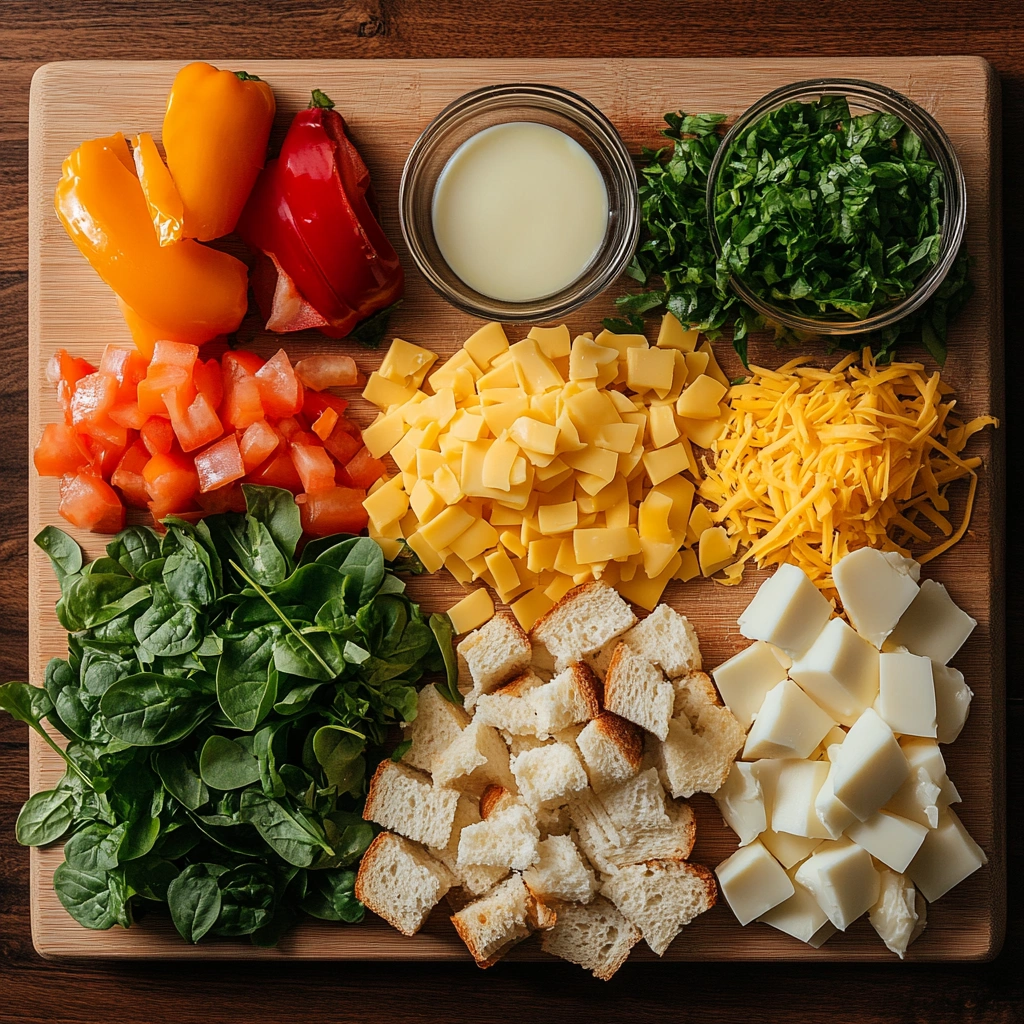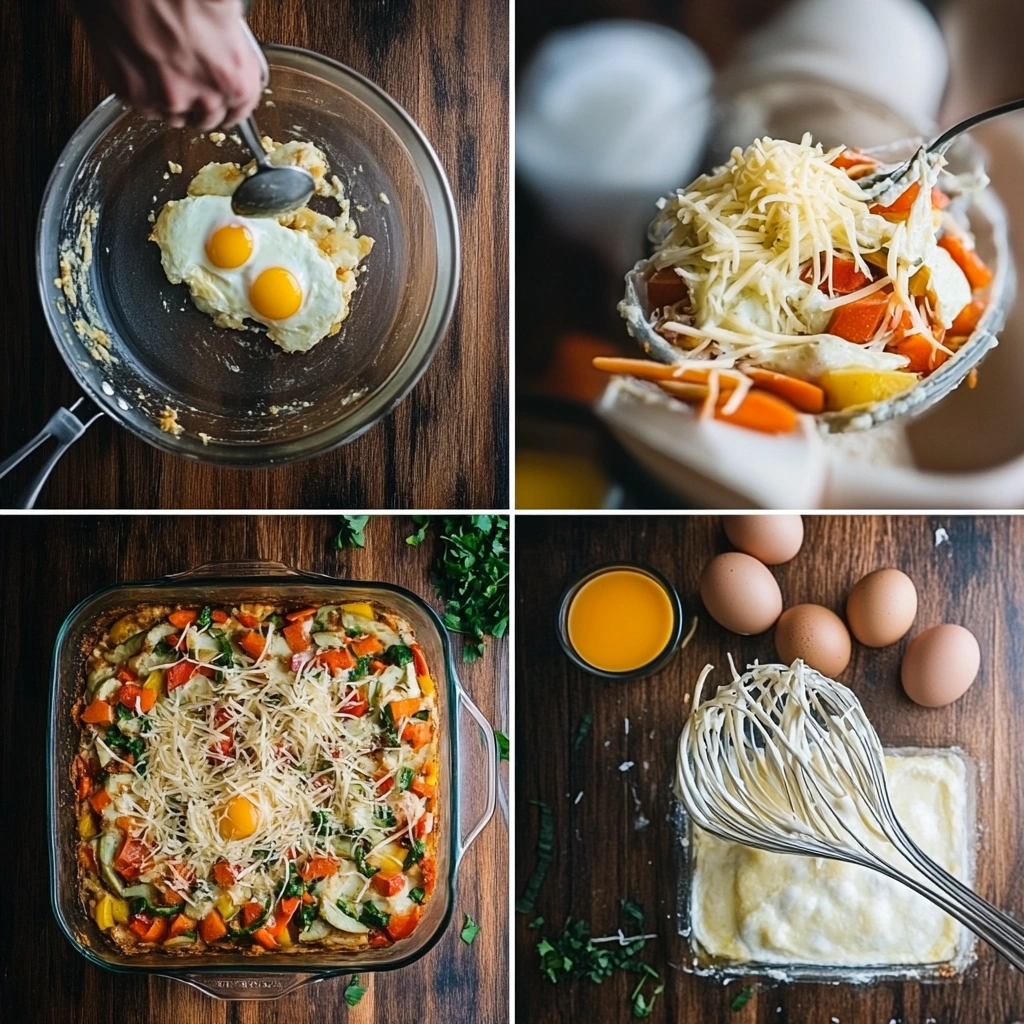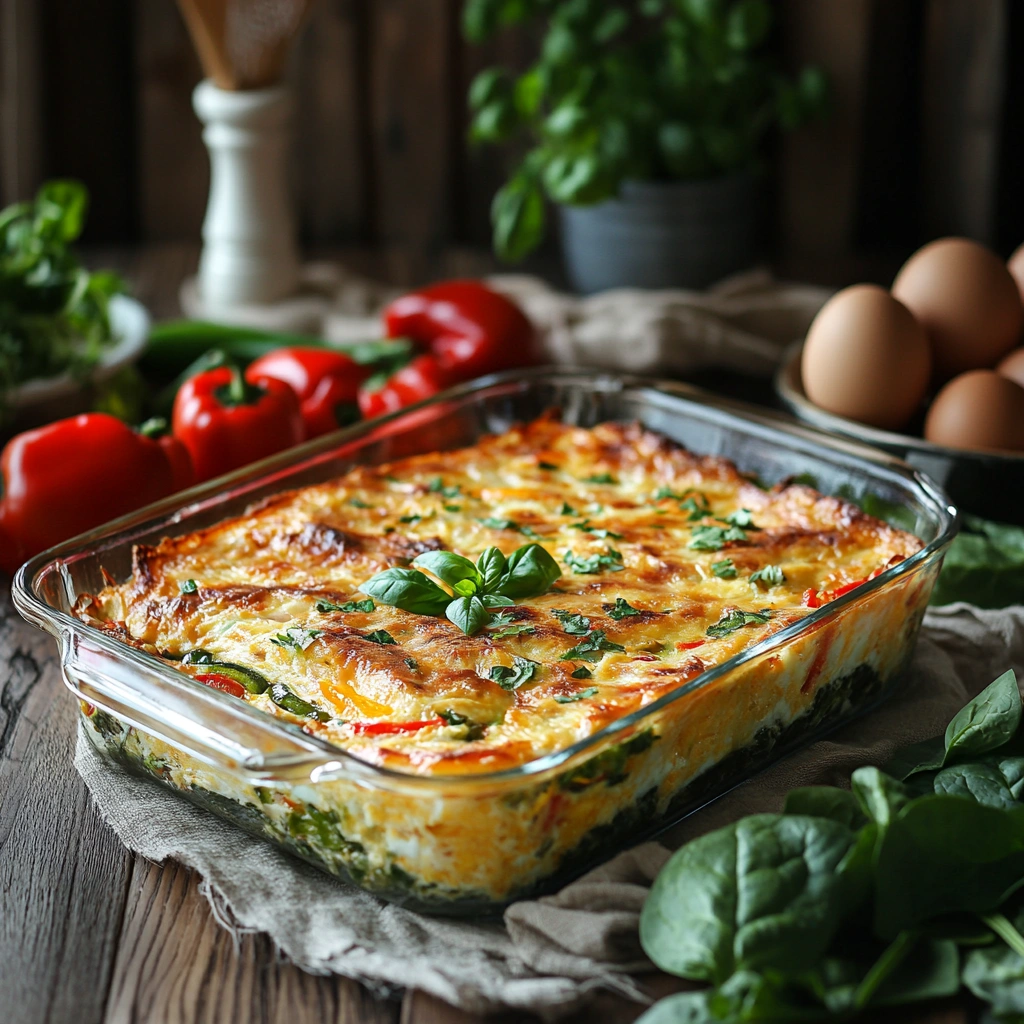A warm, hearty breakfast casserole has long been a staple for weekend mornings, brunch gatherings, or meal-prep enthusiasts. It’s versatile, satisfying, and—let’s face it—an effortless way to feed a crowd. But what is breakfast casserole made of exactly? This article dives deep into the core ingredients, variations, and cooking methods so you can whip up the perfect dish. From eggs to cheese and everything in between, we’ll cover every delicious detail.
Let’s start with understanding what makes this popular dish a timeless favorite.
What is Breakfast Casserole Made Of?
Core Ingredients of a Traditional Breakfast Casserole
At its heart, a breakfast casserole is built on simple yet hearty components that come together to create a rich, satisfying dish. Whether you’re serving it for brunch or prepping it for busy weekdays, these core ingredients ensure a flavorful foundation.
Eggs: The Star of the Show
Eggs are undeniably the foundation of most breakfast casseroles. Acting as the glue that binds the ingredients together, eggs give the casserole its fluffy texture. When baked to perfection, they create a soft, custardy layer that complements other ingredients. You can’t go wrong with a dozen eggs whisked with milk for a traditional casserole base.
Milk or Cream: Enhancing the Texture
The addition of milk or cream creates a smooth, silky custard texture that melts in your mouth. Whole milk is a classic choice, but for extra richness, cream or half-and-half works wonders. Want to lighten it up? Swap it with unsweetened almond or oat milk—it does the trick without compromising flavor.
Bread or Potatoes: The Perfect Starch
Here’s where things get interesting. Traditional breakfast casseroles often feature cubed bread—think stale French bread or sourdough—that soaks up the egg mixture beautifully. But if you prefer a gluten-free twist, diced or shredded potatoes make an excellent substitute. Hash browns, anyone? They add a satisfying bite and hearty texture to the dish.
Cheese: A Creamy, Melty Layer of Flavor
Cheese is what takes a casserole from good to downright irresistible. Sharp cheddar, mozzarella, or even a sprinkle of pepper jack brings creamy richness and flavor. The gooey, melted layer on top? Pure magic. You can mix cheeses too—why stop at one when you can have two?
Meat Options: A Savory Twist
While meat is optional, it’s hard to resist the savory touch it adds to breakfast casseroles. You can use chopped turkey sausage, chicken sausage, or even smoked salmon for a gourmet twist. Pre-cook any meat you choose so it melds perfectly with the casserole without turning greasy.
Optional Ingredients to Enhance Flavor
Breakfast casseroles thrive on versatility. So why not throw in ingredients that elevate its flavor and texture?
Vegetables: Adding Color and Nutrition
Colorful, nutrient-packed veggies are a fantastic addition to breakfast casseroles. Think spinach, diced bell peppers, onions, mushrooms, and zucchini. Not only do they add color, but they also bring a satisfying crunch and balance to the dish. Plus, let’s not forget how nutritious they are.
Herbs and Spices: The Flavor Boosters
A sprinkle of salt and pepper may suffice, but you can amp up the flavor profile with a dash of paprika, garlic powder, or fresh parsley. Want something bold? Add a pinch of smoked paprika or a hint of cumin for a little warmth.
Cheese Variations: Mix It Up
Who says you have to stick to cheddar? Crumbled feta, parmesan, or even creamy goat cheese can completely transform the casserole. Add them on top or mix them throughout for bursts of flavor.
Dietary-Specific Ingredients
For those with specific dietary preferences, breakfast casseroles are wonderfully adaptable.
Gluten-Free Alternatives
Bread can easily be swapped for gluten-free options like cubed gluten-free bread, roasted potatoes, or cauliflower rice. All three deliver the same texture while keeping things gluten-free.
Dairy-Free Swaps
If you’re avoiding dairy, plant-based milks like almond, soy, or oat milk work well as a replacement for cream. Similarly, dairy-free cheese alternatives melt surprisingly well and mimic that rich, cheesy flavor.
Vegetarian and Vegan Options
Skip the meat and add hearty plant-based proteins like crumbled tofu, tempeh, or black beans. For a vegan alternative, use a flaxseed egg mixture in place of regular eggs—it binds everything together just as well.
In a nutshell, breakfast casserole brings flexibility, comfort, and flavor to the table. From eggs and milk to bread and cheese, the ingredients you choose create a dish that’s uniquely yours. Keep it classic or spice things up with veggies and herbs—the options are endless.
How to Make a Breakfast Casserole
Step-by-Step Guide to Preparing Breakfast Casserole
Creating a delicious breakfast casserole doesn’t require a culinary degree. The beauty of this dish lies in its simplicity and adaptability. Whether you’re whipping it up for a special occasion or meal prepping for the week, follow this step-by-step guide to achieve a golden, fluffy masterpiece every time.
Step 1 – Preparing the Ingredients
The key to a seamless casserole assembly is having all your ingredients prepped and ready to go.
- Egg Mixture: Start by cracking about 8–12 large eggs into a bowl. Whisk them together with milk or cream, adding a pinch of salt, black pepper, and your favorite spices like garlic powder or paprika for a flavor boost.
- Vegetables: Dice any fresh vegetables you want to include. Bell peppers, onions, mushrooms, and spinach work particularly well. Sauté the veggies lightly to release moisture—this prevents a soggy casserole later.
- Meat: If you’re including meat, cook it beforehand. Brown turkey sausage or cook chicken sausage until it’s no longer pink. Drain any excess grease to keep the casserole light and fluffy.
- Cheese: Shred your choice of cheese—cheddar, mozzarella, or a mix—and set it aside. Freshly shredded cheese melts better than pre-packaged varieties.
- Starch: If you’re using bread, cut it into cubes or tear it into bite-sized pieces. For potatoes, opt for thawed hash browns or pre-roasted diced potatoes.
Once all the prep work is done, you’re ready to assemble.

Step 2 – Assembling the Casserole
This is where the magic happens! A well-layered casserole ensures every bite is perfectly balanced with flavor and texture.
- Grease the Baking Dish: Start by lightly greasing a 9×13-inch baking dish with cooking spray or a thin layer of butter. This prevents sticking and makes cleanup easier.
- Layer the Base: Spread your chosen starch evenly across the bottom of the dish. Bread cubes or hash browns work as the perfect foundation.
- Add Meat and Vegetables: Distribute the cooked meat and sautéed vegetables evenly over the base. This ensures every bite has a little bit of everything.
- Pour the Egg Mixture: Slowly pour the whisked eggs over the entire dish, making sure the egg mixture seeps into every corner.
- Top with Cheese: Sprinkle shredded cheese generously over the top. If you’re feeling adventurous, add a mix of cheeses for extra flavor.
Step 3 – Baking Instructions
Baking the casserole to golden perfection requires the right temperature and timing.
- Preheat the Oven: Set your oven to 350°F (175°C). Preheating ensures the casserole cooks evenly.
- Bake the Casserole: Cover the dish loosely with aluminum foil and place it in the oven. Bake for about 30–35 minutes to allow the eggs to set.
- Remove the Foil: After 30 minutes, remove the foil and let the casserole bake for another 10–15 minutes. This gives the top a golden, crispy finish while keeping the inside soft and fluffy.
- Check for Doneness: Insert a knife or toothpick into the center. If it comes out clean, the casserole is ready. If not, give it another 5 minutes in the oven.
Common Mistakes to Avoid
Even the most seasoned cooks can hit a few snags when making a breakfast casserole. Avoid these common pitfalls for a foolproof result:
- Skipping the Pre-Cook Step: Always pre-cook meats and sauté vegetables. Raw ingredients release moisture, which can make the casserole watery and unappetizing.
- Overbaking the Eggs: Eggs are delicate, so keep a close eye on the casserole to prevent overcooking. Overbaked eggs can become rubbery instead of tender.
- Not Allowing Resting Time: Once the casserole is out of the oven, let it sit for about 10 minutes before slicing. This allows the layers to settle and makes serving easier.
- Using Too Much Liquid: Be mindful of the milk-to-egg ratio. Adding too much liquid can lead to a soggy texture. Stick to about 1 cup of milk for every 8–10 eggs.
Tips for Serving Breakfast Casserole
- Garnish: Sprinkle fresh herbs like parsley or chives over the top for a pop of color and freshness.
- Pairings: Serve the casserole with fresh fruit, avocado slices, or a light green salad for a balanced meal.
- Storing Leftovers: Store leftovers in an airtight container in the refrigerator for up to 4 days. Simply reheat slices in the microwave or oven for a quick, satisfying breakfast.
With just a little prep and the right baking technique, a breakfast casserole transforms into a warm, fluffy, and crowd-pleasing dish. Whether you’re feeding the family on a lazy Sunday morning or impressing guests at brunch, this foolproof guide ensures success every time.
Variations of Breakfast Casserole
One of the greatest joys of making a breakfast casserole is its sheer versatility. Whether you’re craving a classic version, exploring global flavors, or needing something diet-specific, there’s a variation that fits perfectly. Let’s explore some of the most popular ways to tweak this beloved dish to suit every palate, season, and dietary preference.
Regional Breakfast Casserole Variations
Southern-Style Breakfast Casserole
The South is known for its love of comfort food, and their version of breakfast casserole is no exception. Instead of traditional bread or potatoes, biscuits often serve as the base.
- Layer freshly baked or store-bought biscuits in the bottom.
- Add crumbled turkey sausage, scrambled eggs, and creamy gravy for a rich, savory dish.
- Top it off with a generous helping of sharp cheddar cheese for that final gooey layer.
The result? A hearty, soul-warming casserole perfect for any lazy Sunday brunch.
Mexican-Inspired Breakfast Casserole
Add a little fiesta flair to your breakfast with bold, spicy ingredients. A Mexican-style casserole bursts with flavor and vibrant colors.
- Use tortillas or diced potatoes as the base.
- Layer cooked chorizo or seasoned ground turkey for a punch of protein.
- Add black beans, jalapeños, diced tomatoes, and onions for a zesty twist.
- Top with shredded pepper jack cheese and a sprinkle of cilantro.
Serve with salsa, avocado slices, or a dollop of sour cream for a perfectly balanced bite.
Mediterranean Breakfast Casserole
For a lighter and fresher alternative, a Mediterranean-style casserole incorporates bright flavors and healthy ingredients.
- Use roasted potatoes or quinoa as the base.
- Mix in sautéed spinach, artichokes, sun-dried tomatoes, and crumbled feta cheese.
- Season with oregano, garlic, and a pinch of salt and pepper.
This variation delivers a nutritious and flavorful casserole that feels light yet satisfying.
Seasonal Breakfast Casserole Options
Winter Comfort Casserole
When the weather turns cold, nothing beats a hearty, cozy casserole to warm you up.
- Use diced roasted potatoes or hash browns as the base.
- Add cooked chicken sausage, caramelized onions, and sautéed mushrooms.
- Incorporate a mix of cheddar and Gruyère cheese for a rich, comforting finish.
Perfect for holidays or chilly mornings, this casserole is all about indulgent, stick-to-your-ribs comfort.
Summer Fresh Breakfast Casserole
During warmer months, light and fresh ingredients take center stage.
- Replace heavy bread with layers of roasted zucchini, bell peppers, and cherry tomatoes.
- Add scrambled eggs, fresh basil, and a sprinkle of mozzarella cheese.
- Drizzle with a bit of olive oil before baking for a Mediterranean summer touch.
This variation keeps things light and healthy while showcasing summer’s best produce.
Make-Ahead and Freezer-Friendly Options
One of the best features of a breakfast casserole is its make-ahead convenience. Perfect for busy mornings or feeding guests without the stress, these tips ensure your casserole is ready when you are.

Overnight Breakfast Casserole
- Assemble the casserole the night before.
- Cover it tightly with plastic wrap or foil and refrigerate overnight.
- In the morning, remove it from the fridge, let it come to room temperature for 15 minutes, and bake as instructed.
The overnight rest allows the flavors to meld beautifully, and you save precious time in the morning.
Freezer-Friendly Breakfast Casserole
Want to prep for weeks ahead? A freezer-friendly casserole is the perfect solution.
- Before Baking: Assemble the casserole, wrap it tightly in foil, and freeze. When ready to bake, let it thaw overnight in the fridge and bake as usual.
- After Baking: Let the cooked casserole cool completely, portion it into individual servings, and store them in freezer-safe containers.
Reheat in the microwave or oven for a quick, satisfying meal anytime.
Reheating Tips
To keep the casserole from drying out when reheating, cover it with foil and warm it in a 350°F oven for about 15 minutes. For single servings, a quick zap in the microwave works perfectly.
Dietary-Friendly Breakfast Casserole Ideas
Vegetarian Breakfast Casserole
Skip the meat without sacrificing flavor by loading your casserole with nutrient-rich vegetables.
- Use a base of roasted sweet potatoes or quinoa.
- Add spinach, bell peppers, zucchini, and cherry tomatoes.
- Incorporate crumbled feta or goat cheese for added richness.
Low-Carb and Keto-Friendly Casserole
For those following a low-carb or keto lifestyle, bread and potatoes take a back seat.
- Replace the base with cauliflower rice, roasted broccoli, or sautéed mushrooms.
- Use eggs, heavy cream, and cheese for a protein-packed, creamy layer.
- Add turkey sausage, chicken, or smoked salmon for extra protein.
Gluten-Free Breakfast Casserole
Making a gluten-free breakfast casserole is as simple as swapping out the bread.
- Use hash browns, roasted potatoes, or gluten-free bread as the base.
- Add eggs, cheese, and your favorite meat or veggies.
Gluten-free has never tasted so good!
Tips for Personalizing Your Breakfast Casserole
The possibilities are endless when it comes to customizing your breakfast casserole.
- Spice It Up: Add hot sauce or red pepper flakes for a little heat.
- Cheese Lover’s Dream: Combine different cheeses for extra flavor—cheddar, gouda, and parmesan make a great trio.
- Go Global: Try different international flavors, like Mediterranean, Mexican, or Italian-inspired casseroles.
The key is to experiment with ingredients you love. Whether you’re cooking for yourself, your family, or a crowd, there’s always a version of breakfast casserole that will suit your needs and preferences.
Frequently Asked Questions
What is breakfast casserole made of traditionally?
A traditional breakfast casserole consists of a few simple yet flavorful ingredients. The base typically includes eggs whisked with milk or cream to create a custardy texture. Bread cubes or hash browns serve as the starch, while shredded cheese—like cheddar or mozzarella—adds creamy richness. For added flavor, cooked meats like turkey sausage or chicken sausage are often included, along with sautéed vegetables such as onions, bell peppers, or spinach.
Can I make a breakfast casserole without meat?
Absolutely! A meatless breakfast casserole is just as satisfying and packed with flavor. Simply replace the meat with a variety of vegetables or plant-based proteins. Spinach, mushrooms, zucchini, tomatoes, and bell peppers work beautifully to add texture and color. For a protein boost, try incorporating tofu, black beans, or chickpeas. Cheese lovers can also add a variety of shredded cheeses like feta, mozzarella, or cheddar for a rich and savory dish.
How long does breakfast casserole last in the fridge?
When stored properly, a breakfast casserole can last up to 4 days in the refrigerator. To ensure freshness:
- Allow the casserole to cool completely before covering it tightly with plastic wrap or placing it in an airtight container.
- Reheat individual portions in the microwave or warm the entire dish in the oven at 350°F for 10–15 minutes.
This makes breakfast casseroles an ideal option for meal prep, saving time on busy mornings.
Can you prepare a breakfast casserole the night before?
Yes, preparing a breakfast casserole the night before is a great time-saver. Assemble all the ingredients—layering bread or potatoes, meats, vegetables, and cheese—then pour the whisked egg mixture over the top. Cover the dish tightly with plastic wrap or foil and store it in the refrigerator overnight. In the morning, let the casserole sit at room temperature for 10–15 minutes before baking it as usual. This overnight method enhances the flavors, allowing the bread or potatoes to soak up the eggs and spices.
What are the best cheeses for a breakfast casserole?
The choice of cheese can make or break the flavor of a breakfast casserole. Some of the best cheeses to use include:
- Cheddar: Sharp and melty, it adds a bold flavor.
- Mozzarella: Creamy and mild, it’s perfect for a softer texture.
- Pepper Jack: For a spicy kick.
- Feta: Crumbly and tangy, great for Mediterranean-style casseroles.
- Parmesan: Adds a salty, nutty depth of flavor.
Feel free to mix and match cheeses for added richness. A combination of cheddar and mozzarella is always a crowd-pleaser.
How do you prevent a breakfast casserole from being soggy?
A soggy breakfast casserole can ruin an otherwise delicious dish, but it’s easy to avoid with these tips:
- Sauté Vegetables First: Cook vegetables like onions, mushrooms, and spinach to release excess moisture.
- Pre-Cook Meat: Always cook meats like turkey sausage or chicken sausage before adding them to the casserole.
- Avoid Overloading on Liquid: Use the right egg-to-milk ratio—about 1 cup of milk for every 8–10 eggs. Too much liquid can make the casserole watery.
- Let It Rest: Allow the casserole to sit for about 10 minutes after baking to let the layers settle.
By following these steps, you’ll end up with a perfectly firm and fluffy casserole every time.
Conclusion
A breakfast casserole is the ultimate combination of simplicity, versatility, and flavor. Whether you stick to the traditional recipe with eggs, milk, cheese, and bread or experiment with variations like vegetables, gluten-free options, or meatless alternatives, this dish offers endless possibilities. It’s perfect for feeding a crowd, meal prepping for the week, or simply creating a warm and hearty breakfast for your family.
From understanding what breakfast casserole is made of to discovering tips, tricks, and creative variations, you now have all the knowledge to make the perfect casserole every time. So, gather your favorite ingredients, preheat your oven, and get ready to serve up a satisfying dish that everyone will love.
Make your mornings brighter, simpler, and far more delicious with a homemade breakfast casserole. It’s time to dig in and enjoy!

